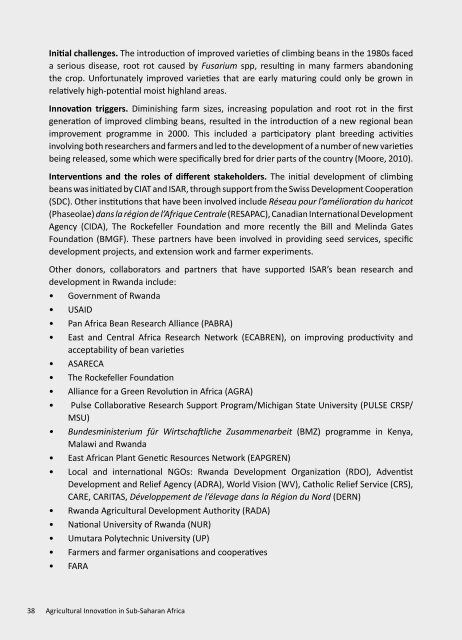1C1KKTs
1C1KKTs
1C1KKTs
You also want an ePaper? Increase the reach of your titles
YUMPU automatically turns print PDFs into web optimized ePapers that Google loves.
Initial challenges. The introduction of improved varieties of climbing beans in the 1980s faced<br />
a serious disease, root rot caused by Fusarium spp, resulting in many farmers abandoning<br />
the crop. Unfortunately improved varieties that are early maturing could only be grown in<br />
relatively high-potential moist highland areas.<br />
Innovation triggers. Diminishing farm sizes, increasing population and root rot in the first<br />
generation of improved climbing beans, resulted in the introduction of a new regional bean<br />
improvement programme in 2000. This included a participatory plant breeding activities<br />
involving both researchers and farmers and led to the development of a number of new varieties<br />
being released, some which were specifically bred for drier parts of the country (Moore, 2010).<br />
Interventions and the roles of different stakeholders. The initial development of climbing<br />
beans was initiated by CIAT and ISAR, through support from the Swiss Development Cooperation<br />
(SDC). Other institutions that have been involved include Réseau pour l’amélioration du haricot<br />
(Phaseolae) dans la région de l’Afrique Centrale (RESAPAC), Canadian International Development<br />
Agency (CIDA), The Rockefeller Foundation and more recently the Bill and Melinda Gates<br />
Foundation (BMGF). These partners have been involved in providing seed services, specific<br />
development projects, and extension work and farmer experiments.<br />
Other donors, collaborators and partners that have supported ISAR’s bean research and<br />
development in Rwanda include:<br />
• Government of Rwanda<br />
• USAID<br />
• Pan Africa Bean Research Alliance (PABRA)<br />
• East and Central Africa Research Network (ECABREN), on improving productivity and<br />
acceptability of bean varieties<br />
• ASARECA<br />
• The Rockefeller Foundation<br />
• Alliance for a Green Revolution in Africa (AGRA)<br />
• Pulse Collaborative Research Support Program/Michigan State University (PULSE CRSP/<br />
MSU)<br />
• Bundesministerium für Wirtschaftliche Zusammenarbeit (BMZ) programme in Kenya,<br />
Malawi and Rwanda<br />
• East African Plant Genetic Resources Network (EAPGREN)<br />
• Local and international NGOs: Rwanda Development Organization (RDO), Adventist<br />
Development and Relief Agency (ADRA), World Vision (WV), Catholic Relief Service (CRS),<br />
CARE, CARITAS, Développement de l’élevage dans la Région du Nord (DERN)<br />
• Rwanda Agricultural Development Authority (RADA)<br />
• National University of Rwanda (NUR)<br />
• Umutara Polytechnic University (UP)<br />
• Farmers and farmer organisations and cooperatives<br />
• FARA<br />
38 Agricultural Innovation in Sub-Saharan Africa


